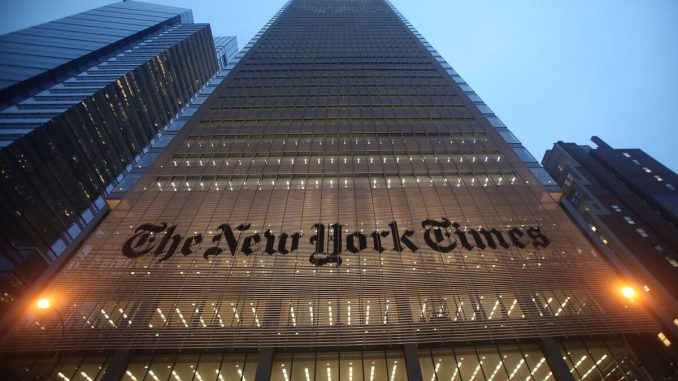

Commentary
Today, the New York Times is a vigorous upholder of the notion that the 2020 election was the most secure in history and that the chances of fraud arising out of absentee ballots or mail-in ballots is simply a “false” GOP allegation.
In a recent fact-check, New York Times reporter Linda Qiu wrote that “there have been numerous independent studies and government reviews finding voter fraud extremely rare in all forms,” including absentee ballots and mail-in ballots between which there is “no meaningful difference.” Both are “secure forms of voting”; even more, they are the “gold standard” of election security.
This consistent message from the New York Times has a clear objective. It seeks to remove all debate over the question of whether making it easier for people to vote, through absentee ballots and mail-in ballots, also raises legitimate problems of voter fraud. According to the Times, this is a bogus problem. The real problem is the malevolence of the GOP in seeking to repress poor people and racial minorities from casting their ballots.
Yet, as RealClearInvestigations points out, the New York Times itself, prior to the 2020 election, sounded numerous alarms about the prospects for fraud as a consequence of expanded absentee-ballots and mail-in ballots. As early as 2004, New York Times reporter Michael Moss fretted that many states had failed to adopt “safeguards on absentee voting that election officials have warned they will need to prevent rigged elections.”
In 2006, New York Times reporter Joyce Pernick noted that “experts in election law say most voter fraud involves absentee balloting.” In 2011, Charlie Savage of the New York Times insisted that, in comparison with in-person voting, there was “greater evidence” that mail-in ballots have “been used to attempt to alter the results of an election.”
Here’s a revealing article from 2012: “Error and Fraud at Issue as Absentee Voting Rises.” Written by Adam Liptak, this New York Times article points out that mail-in voting “increases the potential for fraud,” thus raising “questions about the most elementary promises of democracy.” According to the Times, “Voting by mail is now common enough and problematic enough that election experts say there have been multiple elections in which no one can say with confidence which candidate was the deserved winner.”
Absentee and mail-in ballots, writes Liptak, “make it much easier to buy and sell votes.” Liptak provides the examples of elections in Illinois and Indiana. He also describes a process he calls “granny farming” in which campaign worker supposedly assist voters in nursing homes. These voters are easily “subjected to subtle pressure, outright intimidation, or fraud. The secrecy of their voting is easily compromised. And their ballots can be intercepted both coming and going.”
Liptak quotes Heather Gerken, now the dean of the Yale Law School, fretting that “you could steal some absentee ballots or stuff a ballot box or bribe an election administrator,” adding that the ease of such practices shows “why all the evidence of stolen elections involves absentee ballots and the like.” Gerken, like the Times, now seems to have conveniently forgotten what she said just a few years ago.
So let’s see where we are on this. For years, when absentee and mail-in ballots were relatively scarce, the New York Times was insistent that they posed serious problems of fraud and manipulation. This was not merely the newspaper’s view—it marshalled a wide range of studies and experts to support the point.
Now that mail-in ballots have expanded enormously, largely justified by the limitations on in-person voting caused by COVID-19, one might expect the anxiety of the New York Times to increase. One might expect the Times to warn of far greater threats to election integrity. One might look for the Times to demand the imposition of new safeguards to ensure the integrity of democracy.
But no. Instead, the New York Times, once cautious and somber about the prospects for election fraud as a result of absentee and mail-in ballots, has now completely reversed its position and insists, not merely that there’s a good case to be made for the security of absentee and mail-in ballots, but also that there’s no legitimate debate on the subject of whether such ballots open up opportunities for voter fraud.
What, then, explains the New York Times’ abrupt reversal? The answer, of course, is election outcomes. By and large, the earlier Times articles worried that absentee ballots might put Bush over the top in 2000 or 2004. Or the Times was concerned that absentee ballots might cost Obama his reelection. In 2020, however, the Times recognized that the Democrats had aggressively pushed for expanded mail-in balloting in the expectation that this would give the party a decisive advantage, as seems to have been the case. Consequently, the Times reversed its position because it wanted a different political outcome.
The sordid episode is merely the latest indication that the New York Times doesn’t stand on principle, with regard to mail-in ballots or anything else. Its principles are entirely at the service of its preferred ideological outcomes. The Times, of course, isn’t alone in engaging in this hypocrisy and political rationalization. We can recognize in this hypocrisy and special pleading a vindication of the philosopher David Hume’s contention that “reason is, and ought only to be the slave of the passions.”
Dinesh D’Souza is an author, filmmaker, and daily host of the Dinesh D’Souza podcast.






Be the first to comment